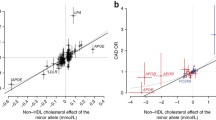Abstract
Raised plasma triglyceride (TG) levels are an independent risk factor for coronary artery disease (CAD), and thus understanding the genetic and environmental determinants of TG levels are of major importance. TG metabolism is a process for delivering free fatty acids for energy storage or β-oxidation, and involves a number of different hydrolytic enzymes and apolipoproteins (apo). The genes encoding these proteins are, therefore, candidates for determining plasma TGs. Although rare mutations in lipoprotein lipase (LPL), the major TG-hydrolyzing enzyme, and apo CII (APOC2), its essential activator, result in extremely high plasma TG levels, their low frequency means they have little impact upon TG levels in the general population. Common mutations in LPL, apo CIII (APOC3), and apo E (APOE) have the strongest effect on plasma TG levels at the population level. In addition, environmental factors such as diet, obesity, and smoking interact with genetic determinants of TG to produce a modulating high-risk environment.
Similar content being viewed by others
References and Recommended Reading
Wilson PW, Abbott RD, Castelli WP, et al.: High density lipoprotein cholesterol and mortality. Arteriosclerosis 1996, 276:544–548.
Hokanson JE, Austin MA: Plasma triglyceride level is a risk factor for cardiovascular disease independent of high-density lipoprotein cholesterol level: a meta-analysis of population-based prospective studies. J Cardiovasc Risk 1996, 3:213–219.
Chapman MJ, Guerin M, Bruckert E: Atherogenic, dense low-density lipoproteins. Pathophysiology and new therapeutic approaches. Eur Heart J 1998, 19(suppl A):A24–30.
Olivecrona G, Olivecrona T: Triglyceride lipases and atherosclerosis. Curr Opin Lipidol 1995, 6:291–305.
Beisiegel U, Weber W, Bengtsson-Olivecrona G: Lipoprotein lipase enhances the binding of chylomicrons to low density lipoprotein receptor-related protein. Proc Natl Acad Sci U S A 1991, 88:8342–8346.
Mahley RW, Ji ZS: Remnant lipoprotein metabolism: key pathways involving cell-surface heparan sulfate proteoglycans and apolipoprotein E. J Lipid Res 1999, 40:1–16.
Kuusi T, Saarinen P, Nikkila EA: Evidence for the role of hepatic endothelial lipase in the metabolism of plasma high density lipoprotein2 in man. Atherosclerosis 1980, 36:589–593.
Yeaman SJ, Smith GM, Jepson CA, et al.: The multifunctional role of hormone-sensitive lipase in lipid metabolism. Adv Enzyme Regul 1994, 34:355–370.
Jong MC, Hofker MH, Havekes LM: Role of ApoCs in lipoprotein metabolism: functional differences between ApoC1, ApoC2, and ApoC3. Arterioscler Thromb Vasc Biol 1999, 19:472–484.
Wang CS, McConathy WJ, Kloer HU, Alaupovic P: Modulation of lipoprotein lipase activity by apolipoproteins. Effect of apolipoprotein C-III. J Clin Invest 1985, 75:384–390.
Shoulders CC, Harry PJ, Lagrost L, et al.: Variation at the apo AI/CIII/AIV gene complex is associated with elevated plasma levels of apo CIII. Atherosclerosis 1991, 87:239–247.
Weisgraber KH, Mahley RW, Kowal RC, et al.: Apolipoprotein C-I modulates the interaction of apolipoprotein E with beta-migrating very low density lipoproteins (beta-VLDL) and inhibits binding of beta-VLDL to low density lipoprotein receptor-related protein. J Biol Chem 1990, 265:22453–22459.
Talmud PJ: Detection and physiological relevance of mutation in the apolipoprotein E, C-II and B genes. In Structure and Function of Apolipoproteins. Edited by Rosseneu M. Baton Rouge: CRC Press; 1992:123–158.
Weinstock PH, Bisgaier CL, Aalto-Setälä K, et al.: Severe hypertriglyceridemia, reduced high density lipoprotein, and neonatal death in lipoprotein lipase knockout mice. Mild hypertriglyceridemia with impared very low density lipoprotein clearance in heterozygotes. J Clin Invest 1995, 96:2555–2568.
Liu MS, Jirik FR, LeBoeuf RC, et al.: Alteration of lipid profiles in plasma of transgenic mice expressing human lipoprotein lipase. J Biol Chem 1994, 269:11417–11424.
Levak Frank S, Hofmann W, Weinstock PH, et al.: Induced mutant mouse lines that express lipoprotein lipase in cardiac muscle, but not in skeletal muscle and adipose tissue, have normal plasma triglyceride and high-density lipoprotein-cholesterol levels. Proc Natl Acad Sci U S A 1999, 96:3165–3170.
Shachter NS, Hayek T, Leff T, et al.: Overexpression of apolipoprotein CII causes hypertriglyceridemia in transgenic mice. J Clin Invest 1994, 93:1683–1690.
Maeda N, Li H, Lee D, et al.: Targeted disruption of the apolipoprotein C-III gene in mice results in hypotriglyceridaemia and protection from postprandial hypertriglyceridaenia. J Biol Chem 1994, 269:23610–23616.
Aalto Setala K, Fisher EA, Chen X, et al.: Mechanism of hypertriglyceridemia in human apolipoprotein (apo) CIII transgenic mice. Diminished very low density lipoprotein fractional catabolic rate associated with increased apo CIII and reduced apo E on the particles. J Clin Invest 1992, 90:1889–1900.
Shachter NS, Ebara T, Ramakrishnan R, et al.: Combined hyperlipidemia in transgenic mice overexpressing human apolipoprotein C1. J Clin Invest 1996, 98:846–855.
van Ree JH, Hofker MH, van den Broek WJ, et al.: Increased response to cholesterol feeding in apolipoprotein C1-deficient mice. Biochem J 1995, 305:905–911.
Plump AS, Smith JD, Hayek T, et al.: Severe hypercholesterolemia and atherosclerosis in apolipoprotein E-deficient mice created by homologous recombination in ES cells. Cell 1992, 71:343–353.
Fazio S, Lee YL, Ji ZS, Rall SC, Jr: Type III hyperlipoproteinemic phenotype in transgenic mice expressing dysfunctional apolipoprotein E. J Clin Invest 1993, 92:1497–1503.
Brunzell JD: Familial lipoprotein lipase deficiency and other causes of the chylomicromemia syndrome. In The Molecular Basis of Inherited Disease. Edited by Scriver CR, Beaudet AL, Sly WS, Valle D. New York: McGraw-Hill; 1989:1165–1180.
Ma Y, Henderson HE, Murphy MR, et al.: A mutation in the human lipoprotein lipase gene as the most common cause of familial chylomicronemia in French Canadians. N Engl J Med 1991, 324:1761–1766.
Mailly F, Palmen J, Talmud PJ, et al.: Familial lipoprotein lipase (LPL) deficiency: a catalogue of LPL gene mutations identified in twenty patients from the UK, Sweden and Italy. Hum Mutat 1997, 10:465–473.
Fisher RM, Humphries SE, Talmud PJ: Common variation in the lipoprotein lipase gene: effects on plasma lipids and risk of atherosclerosis. Atherosclerosis 1997, 135:145–159.
Liu H, Labeur C, Xu C, et al.: Characterization of the lipidbinding properties and lipoprotein lipase inhibition of a novel apolioprotein C-III variant Ala23Thr. J Lipid Res 2000, 41:1760–1771.
Hokanson JE: Lipoprotein lipase gene variants and risk of coronary disease: a quantitative analysis of population-based studies. Int J Clin Lab Res 1997, 27:24–34.
Kastelein JJ, Ordovas JM, Wittekoek ME, et al.: Two common mutations (D9N, N291S) in lipoprotein lipase: a cumulative analysis of their influence on plasma lipids and lipoproteins in men and women. Clin Genet 1999, 56:297–305.
Wittrup HH, Tybjaerg Hansen A, Nordestgaard BG: Lipoprotein lipase mutations, plasma lipids and lipoproteins, and risk of ischemic heart disease. A meta-analysis. Circulation 1999, 99:2901–2907.
Kastelein JJ, Groenemeyer BE, Hallman DM, et al.: The Asn9 variant of lipoprotein lipase is associated with the −93G promoter mutation and an increased risk of coronary artery disease. The Regress Study Group. Clin Genet 1998, 53:27–33.
Jukema JW, van Boven AJ, Groenemeijer B, et al.: The Asp9 Asn mutation in the lipoprotein lipase gene is associated with increased progression of coronary atherosclerosis. Circulation 1996, 94:1913–1918.
Hall S, Chu G, Miller G, et al.: A common mutation in the lipoprotein lipase gene promoter, −93T/G, is associated with lower plasma triglyceride levels and increased promoter activity in vitro. Arterioscler Thromb Vasc Biol 1997, 17:1969–1976.
Ehrenborg E, Clee SM, Pimstone SN, et al.: Erhnic variation and in vivo effects of the −93g-t promoter variation in the lipoprotein lipase gene. Arterioscler Thromb Vasc Biol 1997, 17:2672–2678.
Friday KE, Srinivasan SR, Elkasabany A, et al.: Black-white differences in postprandial triglyceride response and postheparin lipoprotein lipase and hepatic triglyceride lipase among young men. Metabolism 1999, 48:749–754.
Chaturvedi N, McKeigue PM, Marmot MG: Relationship of glucose intolerance to coronary risk in Afro-Caribbeans compared with Europeans. Diabetologia 1994, 37:765–772.
Mailly F, Fisher RM, Nicaud V, et al.: Association between the LPL-D9N mutation in the lipoprotein lipase gene and plasma lipid traits in myocardial infarction survivors from the ECTIM study. Atherosclerosis 1996, 122:21–25.
Zhang H, Henderson H, Gagne SE, et al.: Common sequence variants of lipoprotein lipase: standardized studies of in vitro expression and catalytic function. Biochim Biophys Acta 1996, 1302:159–166.
Rees A, Shoulders CC, Stocks J, et al.: DNA polymorphism adjacent to human apoprotein A-1 gene: relation to hypertriglyceridaemia. Lancet 1983, 1:444–446.
Talmud PJ, Humphries SE: Apolipoprotein C-III gene variation and dyslipidaemia. Curr Opin Lipidol 1997, 8:154–158.
Dammerman M, Sandkuijl LA, Halaas JL, et al.: An apolipoprotein CIII haplotype protective against hypertriglyceridemia is specified by promoter and 3′ untranslated region polymorphisms. Proc Natl Acad Sci U S A 1993, 90:4562–4566.
Li WW, Dammerman MM, Smith JD, et al.: Common genetic variation in the promoter of the human apo CIII gene abolishes regulation by insulin and may contribute to hypertriglyceridemia. J Clin Invest 1995, 96:2601–2605.
Waterworth DM, Ribalta J, Nicaud V, et al.: ApoCIII gene variants modulate postprandial response to both glucose and fat tolerance tests. Circulation 1999, 99:1872–1877.
Eliasson B, Mero N, Taskinen MR, Smith U: The insulin resistance syndrome and postprandial lipid intolerance in smokers. Atherosclerosis 1997, 129:79–88.
Waterworth DM, Talmud PJ, Bujac SR, et al.: The contribution of apoCIII gene variants to the determination of triglyceride levels and interaction with smoking in middle-aged men. Arterioscler Thromb Vasc Biol 2000, 20:2663–2669.
Dallongeville J, Lussier Cacan S, Davignon J: Modulation of plasma triglyceride levels by apoE phenotype: a meta-analysis. J Lipid Res 1992, 33:447–454.
Xu Y, Berglund L, Ramakrishnan R, et al.: A common Hpa I RFLP of apolipoprotein C-I increases gene transcription and exhibits an ethnically distinct pattern of linkage disequilibrium with the alleles of apolipoprotein E. J Lipid Res 1999, 40:50–58.
Talmud PJ, Bujac S, Hall S, et al.: Substitution of asparagine for aspartic acid at residue 9 (D9N) of lipoprotein lipase markedly augments risk of coronary heart disease in male smokers. Atherosclerosis 2000, 149:75–81.
Fisher RM, Mailly F, Peacock RE, et al.: Interaction of the lipoprotein lipase asparagine 291→serine mutation with body mass index determines elevated plasma triacylglycerol concentrations: a study in hyperlipidaemic subjects, myocardial infarction survivors and healthy adults. J Lipid Res 1995, 36:2104–2112.
Author information
Authors and Affiliations
Rights and permissions
About this article
Cite this article
Talmud, P.J. Genetic determinants of plasma triglycerides: Impact of rare and common mutations. Curr Atheroscler Rep 3, 191–199 (2001). https://doi.org/10.1007/s11883-001-0061-4
Issue Date:
DOI: https://doi.org/10.1007/s11883-001-0061-4




